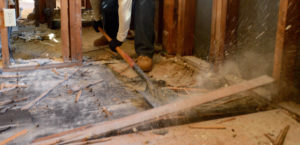Mold on OSB Subfloor in Bathroom
It is quite common to have mold on the subfloor in your bathroom due to all the moisture available. If you have found yourself in this situation, we suggest that you call today to speak with a professional for free.
Why Is Mold a Concern
Mold can cause damage to your health as well as to your property. The health problems mainly arise from mold’s spores and mycotoxins. That being said, some types of mold can pose more of a health risk than others. Here are some general health risks that mold can carry:
- Allergies
- Sleeping issues
- Trouble focusing
If there is mold growing in your property, we suggest that you call today for a free remediation quote.
Can There Be Mold Present Even If It Is Not Visible?
Yes, in fact, it is quite common for a property to have mold in it without the occupants knowing. If you notice any warning signs of mold in your property, including a musty smell, moisture issues, leaks, and poor ventilation, we suggest that you get your property looked at by an industrial hygienist.
Can Mold Inspectors Also Remediate?
In most states, it is illegal for a mold inspector to also remediate the mold due to the conflict of interest that it presents.
Is Mold Damage Covered by Insurance?
There are many different insurance policies out there, and thus this really depends on your specific policy. We recommend speaking directly with your insurance company to see if it is.
Is Bleach Effective for Mold Remediation?
The short answer to this is no. The EPA generally does not recommend using bleach for mold remediation for various reasons, including that it does not do much to remove mold spores from the air. Using bleach can lead to the mold growing back or the spores spreading to other parts of the property.
What to Do If You’re Buying or Renting a New Property
Mold damage can be expensive to restore and may also indicate that the property has other issues, like water damage. If you are buying or renting a new property, we suggest that you get it tested by a professional for pests as well as toxins, like mold.
Protective Gear for Mold Abatement
Protective gear is important for keeping you or your restoration contractor safe during the remediation process. Here are some pieces of gear that are regularly used:
- Mask or respirator
- Protective Eyewear
- Gloves
- Full body suits that are sanitizable or disposable
Where Does Mold Commonly Grow?
Mold usually grows in wet climates, but can be found almost anywhere. Some factors that create the ideal conditions for mold are:
- Poor air circulation
- Moisture
- Temperatures of around 70 degrees Fahrenheit
HEPA Filters
HEPA is an acronym for high-efficiency particulate air. Professionals use this air filtration system to help remove spores from the atmosphere. If you would like to purchase a HEPA filter to run in your property, check out our recommended products page.
How to Stop Mold from Coming Back
These tasks can help stop mold from returning:
- Detect and fix the moisture issues quickly
- Run a dehumidifier in commonly damp areas
- Open doors and windows when possible for better air circulation
- Waterproofing your property
Moisture Source Detection and Repair
Because moisture is an important factor needed for mold growth, it should be detected and fixed quickly. In order to do this, you or a professional should use a moisture meter like the one found here. Once the moisture source is detected, your restoration contractor may need to suggest a plumber to help you repair it.
Water Damage Restoration
In order to repair the remaining water damage, we suggest getting a quote from a professional. They will typically dry your property using fans and dehumidifiers.
Isolating an Area
One of the first steps of mold remediation is making sure that an area is properly isolated with polyethylene sheeting. The main benefit this provides is that it helps lower the chances of mold spreading and growing back.
Demolishing Contaminated Building Materials
After the area is isolated, a professional can go in and remove the contaminated building materials. It is a good idea to use negative air pressure during this process to direct mold spores outside. After the materials have been removed, they should be properly bagged and disposed of.
Throwing Away Contaminated Building Materials
It is important that you properly dispose of mold contaminated materials to lessen the chances of mold returning. Mold specialists should double bag the materials in polyethylene bags and clean the outside of these bags with disposable wipes.
Sanitizing and Repairing Mold Damaged Items
If your personal belongs have become contaminated with mold, your mold professional can help clean them. Most people have porous and non-porous materials. Typically non-porous materials can be sanitized and used again, while porous materials, like drywall or clothing, are regularly thrown away. You can help your restoration contractor decide which items are worth salvaging and which are not.
